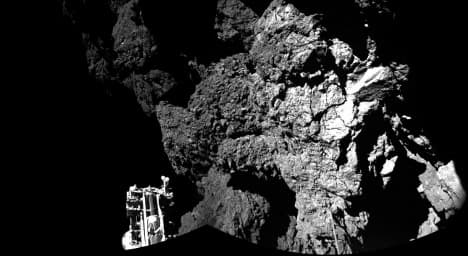Comet probe Philae 'perched on steep slope'

The European probe Philae was "working well" but was likely perched on a steep slope on its host comet, the mission head for France's CNES space agency said on Thursday, a day after the probe made its historic landing.
Some data suggested the washing machine-sized probe may have touched down three times on the low-gravity comet, which is zipping towards the Sun at 18 kilometres per second (11 miles per second), according to updates from ground control.
Philae's anchoring harpoons failed to deploy, but it still managed to send back scientific data for the European Space Agency (ESA) flagship mission as well as the first picture ever taken from the surface of a comet.
"Philae is working well. Its battery is working well and is providing power," mission head Philippe Gaudon of France's CNES space agency told AFP by phone from ground control in Toulouse on Thursday.
But photos the robot lab had sent suggested "it is likely on a steep slope".
A tweet in the name of Philae's MUPUS onboard instrument said: "Magnetic analysis reveals 3 landings at 15:33, 17:26 & 17:33 UTC (GMT)."
"Short status update: we believe that Philae bounced (possibly 3 times) but sits safely on the comet now," said another at 0800 GMT.
The ESA was to brief the press at 1300 GMT.
Equipped with ten instruments, Philae is designed to carry out an array of experiments on Comet 67P/Churyumov-Gerasimenko.
It is the highlight of a massive €1.3 billion ($1.6 billion) project more than two decades in the making.
The mission aims to test theories that comets -- primordial clusters of ice and dust -- hold secrets about how the Solar System was constructed 4.6 billion years ago, and may also have seeded Earth with some of the ingredients for life.
Rosetta, carrying Philae, was hoisted into space in 2004, and took more than a decade to reach its target in August this year, having used the gravitational pull of Earth and Mars as slingshots to build up speed.
The pair covered 6.5 billion kilometres (four billion miles) together before Wednesday's separation and Philae's 20-kilometre descent.
The first signal confirming touchdown was met with jubilation at ground control in Darmstadt, Germany.
But this was soon replaced by worry when fluctuations in the radio signal indicated the 100 kilogramme (220 pound) lander may have lifted off again.
Jean-Yves Le Gall, head of France's CNES space agency, on Thursday reported "three pieces of good news" about Philae while a check-up was underway.
"Philae spent the night on the comet and we have three pieces of good news: the first is that Philae has landed on the comet," he said on Europe 1 radio.
"Secondly, Philae is receiving energy, its solar panels are activated and this allows it to envisage a future. Thirdly, we are in permanent contact with Philae, via Rosetta."
Comments
See Also
Some data suggested the washing machine-sized probe may have touched down three times on the low-gravity comet, which is zipping towards the Sun at 18 kilometres per second (11 miles per second), according to updates from ground control.
Philae's anchoring harpoons failed to deploy, but it still managed to send back scientific data for the European Space Agency (ESA) flagship mission as well as the first picture ever taken from the surface of a comet.
"Philae is working well. Its battery is working well and is providing power," mission head Philippe Gaudon of France's CNES space agency told AFP by phone from ground control in Toulouse on Thursday.
But photos the robot lab had sent suggested "it is likely on a steep slope".
A tweet in the name of Philae's MUPUS onboard instrument said: "Magnetic analysis reveals 3 landings at 15:33, 17:26 & 17:33 UTC (GMT)."
"Short status update: we believe that Philae bounced (possibly 3 times) but sits safely on the comet now," said another at 0800 GMT.
The ESA was to brief the press at 1300 GMT.
Equipped with ten instruments, Philae is designed to carry out an array of experiments on Comet 67P/Churyumov-Gerasimenko.
It is the highlight of a massive €1.3 billion ($1.6 billion) project more than two decades in the making.
The mission aims to test theories that comets -- primordial clusters of ice and dust -- hold secrets about how the Solar System was constructed 4.6 billion years ago, and may also have seeded Earth with some of the ingredients for life.
Rosetta, carrying Philae, was hoisted into space in 2004, and took more than a decade to reach its target in August this year, having used the gravitational pull of Earth and Mars as slingshots to build up speed.
The pair covered 6.5 billion kilometres (four billion miles) together before Wednesday's separation and Philae's 20-kilometre descent.
The first signal confirming touchdown was met with jubilation at ground control in Darmstadt, Germany.
But this was soon replaced by worry when fluctuations in the radio signal indicated the 100 kilogramme (220 pound) lander may have lifted off again.
Jean-Yves Le Gall, head of France's CNES space agency, on Thursday reported "three pieces of good news" about Philae while a check-up was underway.
"Philae spent the night on the comet and we have three pieces of good news: the first is that Philae has landed on the comet," he said on Europe 1 radio.
"Secondly, Philae is receiving energy, its solar panels are activated and this allows it to envisage a future. Thirdly, we are in permanent contact with Philae, via Rosetta."
Join the conversation in our comments section below. Share your own views and experience and if you have a question or suggestion for our journalists then email us at [email protected].
Please keep comments civil, constructive and on topic – and make sure to read our terms of use before getting involved.
Please log in here to leave a comment.